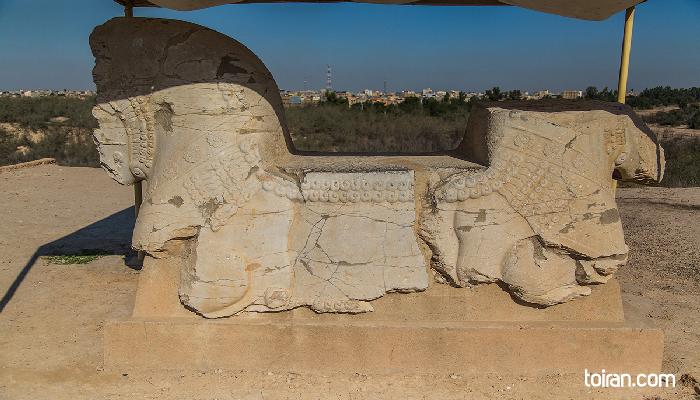Apadana Palace, which means Royal Audience Hall, in Shush was the winter palace of Achaemenid King Darius I (550-486 BC) who built it over the ruins of an older Elamite structure around 521 BC to 515 BC. The Achaemenids later replicated Apadana Palace in Persepolis but on a larger scale.
During the reign of Artaxerxes I (?- 424 BC) the palace fell prey to a fire but was rebuilt by Artaxerxes II (435- 358 BC). The palace was once again devastated in 330 BC after the death of Alexander of Macedonia (356-323 BC), who had invaded the Persian Empire.
Excavations at the site began in the 1800s. Archeologists believe this palace, which had a hall with 72 stone pillars, could have easily accommodated 10,000 people. The pillars of Apadana are each 20 meters tall and were once covered in colorful decorations and had column capitals that were double bull protomes.
Apadana consisted of an audience hall, a reception hall, a harem, a gate and six courtyards tiled with ochre colored bricks. The largest of these courtyards has a number of holes that archeologists believe were used to display flags. Experts believe this courtyard was used for military purposes and was also where soldiers and palace guards gathered.
The palace had terraces with 12 columns on the east, north and west. So far 110 of the rooms and halls of this palace have been discovered. The walls of the palace were decorated with glazed bricks bearing images of twelve petal lotus flowers, the Immortals (Imperial Guards) and winged lions.
Today, almost none of these decorations are still at the palace. A team of French archeologists, who excavated the site in the Qajar era (1785-1925), moved the majority of these decorations along with the other treasures found at this palace to the Louvre where they are on display.
One of the figures, who greatly contributed to the removal of the artifacts and decorations belonging to Apadana Palace, is French archaeologists Jane Dieulafoy (1851 –1916). In her memoires, Dieulafoy writes about uncovering a gargantuan stone bull and taking a mallet to the statue in rage and destroying it as moving it was impossible due to its massive size. Dieulafoy may be celebrated as a brilliant archeologist in her native France but in Iran she is known as the woman who destroyed and looted many of the country’s ancient and cultural artifacts.
Apadana Palace was registered as a National Heritage Site in 2002.



